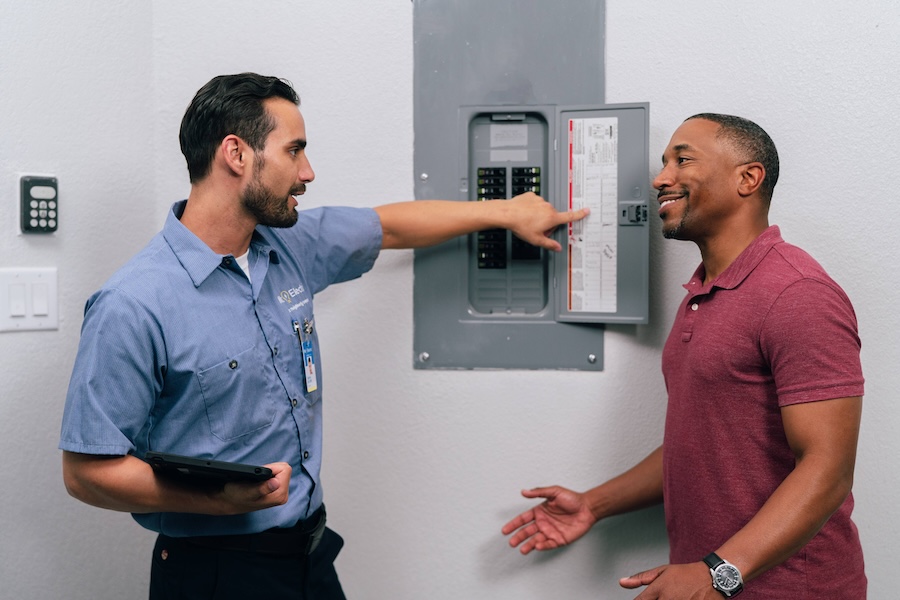Call this Monday to Get 10% OFF (Maximum $100 Off)
Call this Monday to Get 10% OFF (Maximum $100 Off)
24-Hour Emergency Electricians in Greer
Call this Monday to Get 10% OFF (Maximum $100 Off)
Call this Monday to Get 10% OFF (Maximum $100 Off)
24-Hour Emergency Electricians in Greer

Walk into any modern home and you’ll find dozens of devices pulling electricity around the clock. From high-efficiency refrigerators to multiple televisions, charging stations, and central air systems, today’s households demand a lot more power than they did a generation ago. The hub that keeps all of this running is the electrical panel. When the panel can’t handle the load, the signs show up in frustrating or dangerous ways, like tripped breakers, dimming lights, or warm outlets. Mr. Electric wants homeowners to recognize these signals early and understand when a system is falling behind. Keep reading to find out how to tell if your electrical panel is still up to the task, or if it’s time for electrical panel replacement.
A breaker that trips again and again is a sign something is wrong. Breakers protect wiring by cutting power when the load is too heavy, so repeated trips mean the panel is overworked. Flickering or dimming lights are another clue. If the air conditioner turns on and the lights dip, the system is straining. The same goes for small appliances. When running a microwave or vacuum makes the lights change, the panel may be undersized. Outlets that buzz, spark, or feel warm are also red flags. These signs show circuits are near or past their safe capacity, creating both inconvenience and fire risk. Unusual sounds near the panel are worth taking seriously. Breakers and wires under too much load sometimes give off a faint buzzing or humming noise. In advanced cases, you might notice a burning smell near the panel or an outlet. That is an emergency situation that calls for immediate help from electricians.
Decades ago, most homes had a single television, one refrigerator, and a few lamps. Panels rated for 60 or 100 amps were enough. That world is long gone. Today, it’s common for households to have:
Knowing your panel’s rating helps you understand its limits.
When you aren’t sure what your panel is rated for, look for the label inside the door of the breaker box. If you can’t find it, a professional can tell you at a glance. Matching the rating to your household’s demand is needed to prevent overloaded circuits.
Some homeowners delay upgrades because the system still “works.” That can be an expensive mistake. Overloaded panels put strain on wiring, which creates excess heat. This can damage insulation and increase the risk of electrical fires. Insurance companies can deny claims when they find out that outdated or recalled panels were involved in an incident. A panel that’s too small also drags down efficiency. Appliances may wear out sooner if they aren’t getting consistent voltage. Electronics are vulnerable to surges and voltage drops that can cause sudden failures. In most cases, the hidden costs of keeping an outdated system end up higher than the price of an upgrade. Resale value is another factor, since buyers quickly notice when a home has an undersized panel. A property owner who has neglected to schedule an electrical service can struggle with the market or invite demands for credits during inspection.
An inspection is the most reliable way to know. Electricians measure the load on your home, check the rating of your current panel, and evaluate the condition of the breakers and wiring. You’ll likely need electrical panel replacement if:
Some panels from the 1960s through 1980s, like certain Federal Pacific and Zinsco models, are now considered fire hazards. If you own one of these, replacement is urgent.
Replacing a panel involves a full electrical service upgrade, which may include:
The process usually takes one to two days, depending on the complexity of the home’s wiring. Power will be off for several hours while the work is completed. Costs vary, but a professional will give you a detailed estimate. Factors include the size of the upgrade, the condition of your wiring, and whether other updates are needed. It’s worth investing in, since a safe and reliable system can serve the home for decades.
A home that depends on an undersized panel is unsafe. Breaker trips, flickering lights, and buzzing outlets are all signals that the system is struggling. The best step is to call local electricians who can review your system and guide you toward the right solution. Mr. Electric provides dependable inspections and professional electrical panel replacement. Our team makes sure your home is safe, efficient, and prepared for the future. Contact us today to schedule an appointment.
Your Ring doorbell is supposed to keep an eye on your home no matter what's happening outside, but extreme weather can interfere with…
Read More +Quality power starts with a safe path for electricity to follow. At Mr. Electric, we've seen how small grounding issues can turn into…
Read More +Homes built years ago were never designed for the number of devices and appliances people rely on today. An electrical panel replacement…
Read More +Rental properties hide more surprises than many new landlords expect, and the biggest surprises tend to show up once the panel is opened…
Read More +